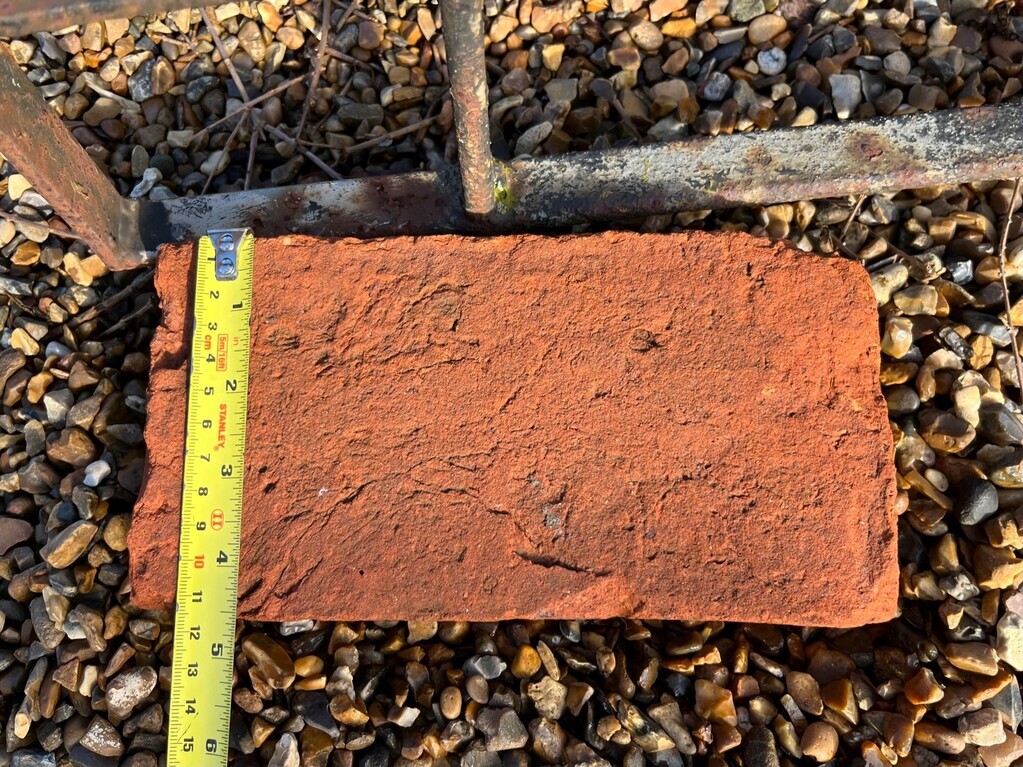Shall we move from threads to something that on the face of it doesn’t seem that interesting or regulated, but is just as crazy?
What am I talking about? Bricks!
You wouldn’t think bricks are the most interesting topic of discussion, but you’d be surprised what they can tell you about a house.
The size, material, where they are made, the shape of them, all vary massively and have been subject to various controls over the years, control that is intrinsically linked to the history of Britain and its colonies.
Although the romans brought brick to Britain, once they left they fell out of favour, and for the entire medieval period were pretty much forgotten about in England up until the Tudor period, and were generally viewed as an inferior building material to stone or wood. A combination of factors saw to their rise to popularity again in the Tudor period, that being a shortage of good building stone in the eastern half of the country, a shortage of good wood as it was being used for warships, and a rise in influence and fashions from European countries where brick was the preferred building material- particularly the Low Countries.
Buildings such as Hampton Court Palace being built in brick quickly cemented (lol) brickwork as a building material of the fashionable elite, a trend which filtered down into vernacular buildings.
This was particularly the case after the restoration of the monarchy, as Charles the second had a particular taste for Dutch fashions. Also law changes after the great fire of London requiring all rebuilding to be done in non flammable materials lead to an explosion in brick making as there just wasn’t the stone available to accommodate it.
The dimensions of bricks are typically factors- one by a half by a quarter. This is obviously very handy for building different size buildings. As to get things to go to together you just turn the brick. They are also generally regarded as being sized around a man’s hand- any wider than the typical 4.5 inches wide and you can’t pick one up one handed.
The size of bricks has been controlled by laws numerous times over the years. The first brick charter setting the actual size of bricks (in an attempt to aid standardisation) was in 1571, at 9inches by 4-1/2 inches by 2-1/4 inches.
By 1776 they went to 9x4.5x3. A little odd, but still a usable factor as 3 goes into 9.
One thing that really upset brick sizing was the brick tax levied by George the third to fund the American war of independence. It was decided that bricks were to be taxed by the thousand. Obviously the first thing that brick makers did was make bricks bigger so you needed less of them, so paid correspondingly less tax- some hilariously so, with bricks that were 9x4-1/2x4-1/2. It was basically two bricks! They must have taken some firing. The Government retaliated by setting the maximum volume of a brick, but they still tended to be a bit bigger then they were before the tax.
When the brick tax was abolished in 1850, bricks gradually shrank back down to the old, factored sizes presumably as they fired better. The final set of brick sizes at 8.5x4x 2.5 inches, which is what a standard modern brick still is to this day. This is still sort of factored, but accounting for your half inch mortar joint.
What I’m circling round to is a critical appraisal of the bricks on this house. Here’s a pic of the unrendered, largely unmessed with area round the back.

These are fairly poorly made, and hand shaped and fired, proably done on-site or fairly locally, which you wouldn’t think would tell you much. Or maybe it does? They have bits of shell, reed and river stones in them if you look closely, so they’re certainly not a commercially made newer brick!
I really should take a proper pic of those ‘foundations’ too. They’re hilarious, some not particularly large blocks of stone set on the dirt (sand) with a single double width course of bricks and then build the wall up from that!
That sizing is important though


Ohhh now isn’t that interesting. them being nominally 2-1/4”x 9” on the exposed face means they were made between 1571 and 1776.
Any house made entirely of pre-3inch bricks is something pretty old and pretty special. I was certainly pretty surprised by this development!
As well as the bricks themselves. The bond is also important (the interlocking pattern of the brick) as this can be used in dating too. The Flemish bond was revolutionary in brickwork, as you need less good quality facing bricks in a Flemish bond, so it’s cheaper. Flemish bond means alternating stretcher and header bricks in every course. It makes it’s way over here in the 1630s, but wast In really common use until the 1680s. In the provinces english bond (bricks laid stretcher with a course of headers every few courses, as per this wall) persisted even longer.
The bond use here isn’t even ‘standard’ English bond which is one header course every other, it’s one header every 5, which has various names such as common bond, English garden wall bond, or Scottish bond. It’s generally used more the further north you go, and again is a cost thing.
My newfound knowledge on bricks, along with the other discoveries I’d made absolutely blew the dating of this place out the water. The proportions of the house always made me think it was older than eluded to, It’s certainly a lot older than you’d expect at first glance.
I was starting to appreciate I was onto something a bit special here, a real survivor hidden in plain sight.
What am I talking about? Bricks!
You wouldn’t think bricks are the most interesting topic of discussion, but you’d be surprised what they can tell you about a house.
The size, material, where they are made, the shape of them, all vary massively and have been subject to various controls over the years, control that is intrinsically linked to the history of Britain and its colonies.
Although the romans brought brick to Britain, once they left they fell out of favour, and for the entire medieval period were pretty much forgotten about in England up until the Tudor period, and were generally viewed as an inferior building material to stone or wood. A combination of factors saw to their rise to popularity again in the Tudor period, that being a shortage of good building stone in the eastern half of the country, a shortage of good wood as it was being used for warships, and a rise in influence and fashions from European countries where brick was the preferred building material- particularly the Low Countries.
Buildings such as Hampton Court Palace being built in brick quickly cemented (lol) brickwork as a building material of the fashionable elite, a trend which filtered down into vernacular buildings.
This was particularly the case after the restoration of the monarchy, as Charles the second had a particular taste for Dutch fashions. Also law changes after the great fire of London requiring all rebuilding to be done in non flammable materials lead to an explosion in brick making as there just wasn’t the stone available to accommodate it.
The dimensions of bricks are typically factors- one by a half by a quarter. This is obviously very handy for building different size buildings. As to get things to go to together you just turn the brick. They are also generally regarded as being sized around a man’s hand- any wider than the typical 4.5 inches wide and you can’t pick one up one handed.
The size of bricks has been controlled by laws numerous times over the years. The first brick charter setting the actual size of bricks (in an attempt to aid standardisation) was in 1571, at 9inches by 4-1/2 inches by 2-1/4 inches.
By 1776 they went to 9x4.5x3. A little odd, but still a usable factor as 3 goes into 9.
One thing that really upset brick sizing was the brick tax levied by George the third to fund the American war of independence. It was decided that bricks were to be taxed by the thousand. Obviously the first thing that brick makers did was make bricks bigger so you needed less of them, so paid correspondingly less tax- some hilariously so, with bricks that were 9x4-1/2x4-1/2. It was basically two bricks! They must have taken some firing. The Government retaliated by setting the maximum volume of a brick, but they still tended to be a bit bigger then they were before the tax.
When the brick tax was abolished in 1850, bricks gradually shrank back down to the old, factored sizes presumably as they fired better. The final set of brick sizes at 8.5x4x 2.5 inches, which is what a standard modern brick still is to this day. This is still sort of factored, but accounting for your half inch mortar joint.
What I’m circling round to is a critical appraisal of the bricks on this house. Here’s a pic of the unrendered, largely unmessed with area round the back.

These are fairly poorly made, and hand shaped and fired, proably done on-site or fairly locally, which you wouldn’t think would tell you much. Or maybe it does? They have bits of shell, reed and river stones in them if you look closely, so they’re certainly not a commercially made newer brick!
I really should take a proper pic of those ‘foundations’ too. They’re hilarious, some not particularly large blocks of stone set on the dirt (sand) with a single double width course of bricks and then build the wall up from that!
That sizing is important though


Ohhh now isn’t that interesting. them being nominally 2-1/4”x 9” on the exposed face means they were made between 1571 and 1776.
Any house made entirely of pre-3inch bricks is something pretty old and pretty special. I was certainly pretty surprised by this development!
As well as the bricks themselves. The bond is also important (the interlocking pattern of the brick) as this can be used in dating too. The Flemish bond was revolutionary in brickwork, as you need less good quality facing bricks in a Flemish bond, so it’s cheaper. Flemish bond means alternating stretcher and header bricks in every course. It makes it’s way over here in the 1630s, but wast In really common use until the 1680s. In the provinces english bond (bricks laid stretcher with a course of headers every few courses, as per this wall) persisted even longer.
The bond use here isn’t even ‘standard’ English bond which is one header course every other, it’s one header every 5, which has various names such as common bond, English garden wall bond, or Scottish bond. It’s generally used more the further north you go, and again is a cost thing.
My newfound knowledge on bricks, along with the other discoveries I’d made absolutely blew the dating of this place out the water. The proportions of the house always made me think it was older than eluded to, It’s certainly a lot older than you’d expect at first glance.
I was starting to appreciate I was onto something a bit special here, a real survivor hidden in plain sight.














 Basically self tappers!!
Basically self tappers!!

